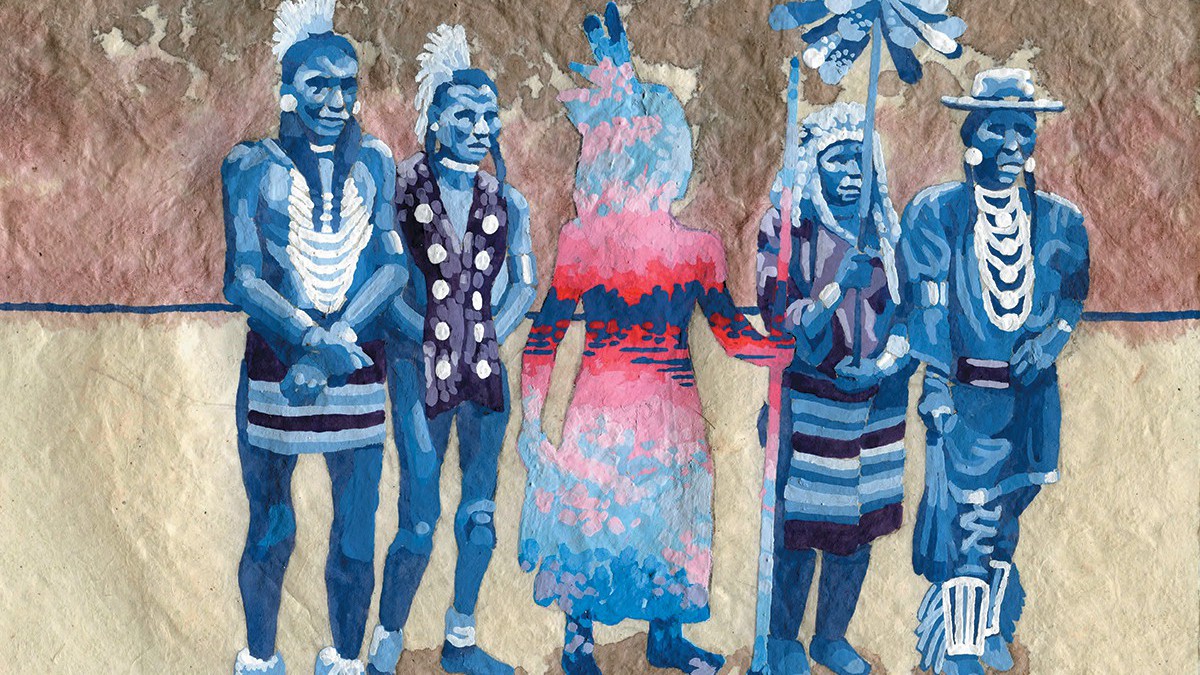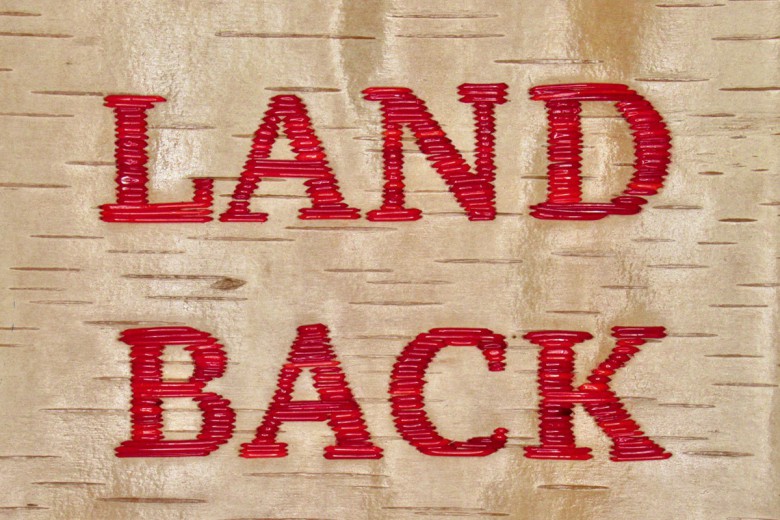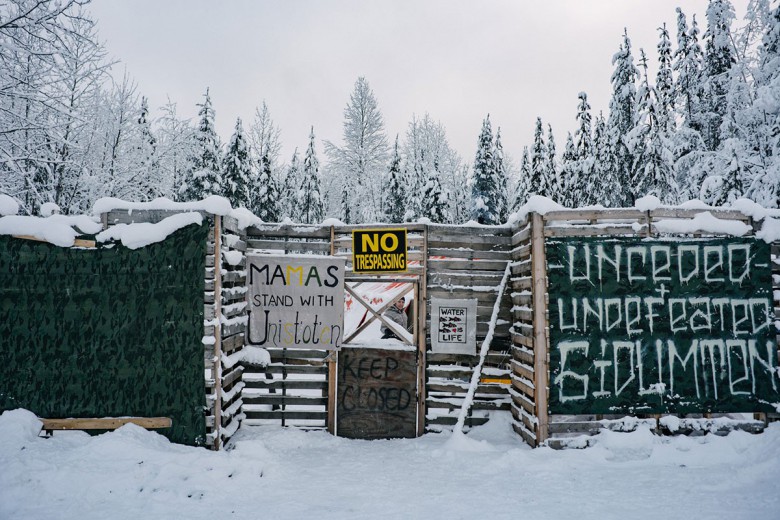“But land-based does not have to mean landlocked.”
—Lou Cornum, “The Space NDN’s Star Map,” The New Inquiry
When Edward S. Curtis travelled thousands of miles photographing Indigenous people in the early 20th century, he did it because he was convinced that Indigenous people were “passing into the darkness of an unknown future.” He spent 30 years of his life on this exercise. His photographs failed to explain the people, land, and customs he portrayed, and instead he fashioned blurred subjects into a monolith. Soon after his popular collection, The Vanishing Race, was published in 1904, railway companies began advertising trips on which settlers could venture to see the subjects of his photography before it was too late. Curtis had cemented the idea in the settler imagination that Indigenous people are stagnant, frozen in a black-and-white photograph.
But not all Indigenous people have remained in one place. For different reasons and with different degrees of freedom, Indigenous people have, in fact, travelled across huge masses of land toward each other onto foreign territories. To be Indigenous means to have a profound relationship to a specific territory, and this relationship persists despite colonialism. Today, many Indigenous people have been forced off their ancestral territories by resource extraction, colonial laws, genocide, and systemic poverty. Other times, we have chosen movement for ourselves: for love, family, community, education, knowledge recovery, and sharing.
The fact that Indigenous people are dynamic travellers who seek new relationships undermines the idea that we are alive only in a historic past.
My and my family’s story is one that combines many of these reasons. I am the Puebla Nahua daughter and granddaughter of Natives who moved from a plot of farmland on the side of a mountain in central Mexico just outside of the city of Zacatlán – first to urban centres and then across borders. I followed my mother and her father’s direction north and now live on Treaty 13 territory in Tkaronto. I am in the lifelong process of asking myself: What is my responsibility to the land I am on and the Indigenous communities of this territory? How do I resist the careless equation of the stories, practices, and struggles of my ancestors and family with those of the people who now host me in this land far from home? Can I do this while also holding on to the ties I have to Indigenous Peoples across the so-called Americas and even across the world?
The fact that Indigenous people are dynamic travellers who seek new relationships undermines the idea that we are alive only in a historic past. It also disrupts the idea that all Indigenous people are the same – when we visit each other’s territories we must grapple with our differences and negotiate our obligations to the title holders of the land to which we arrive. At the same time, pausing to appreciate our similarities can be powerful. My friend Xicotencatl Maher Lopez puts it best when I ask him what it means to be a Tlaxcaltec Nahua, native to Mexico, living on Treaty 3 territory in Canada. He explains that when he introduces himself in Indigenous spaces he says to others: “We have migration stories linked together.” He adds: “In talking about how much we have shared, it really helps bring down the border in the mind, you know?”
I wonder: Are we living in a future where Indigenous people look beyond the colonial borders that were cut through our lands? Could we turn toward an international Indigenous solidarity?
Controlling Indigenous movement
In Canada, there is an almost constant history and present reality of forced displacement and restriction of the movement of Indigenous Peoples. In the late 19th and early 20th centuries, the Canadian government implemented the pass system, which required First Nations people to have documented approval from an Indian agent to travel off of reserves. These kinds of policies continue in cities, where the practice of carding means Indigenous people can be stopped, questioned, and documented by police for no reason, denying them unimpeded movement on their own land.
The border between Canada and the United States remains the longest international boundary in the world, disrupting the contiguous territories of Indigenous Nations like the Sinixt, who had to fight to have their Indigenous Rights recognized in Canada after the border bisected their land and their members were declared extinct by the Canadian government. These nations are forced to contend with extreme limits on their members’ freedom of movement – members of the Blackfoot Confederacy, whose land was similarly cleaved by the border, have reported being questioned and harassed by border agents despite the Jay Treaty’s assurance that Indigenous people would be allowed to travel freely across the border. In Akwesasne, Mohawks are forced to traverse multiple borders between Quebec, Ontario, and New York, which can result in hours of travel and waiting.
They have been separated from their children by border agents who do not speak K’iche’, Mam, Achi, Ixil, Awakatek, Jakaltek, and Q’anjob’al – Indigenous dialects that ring through U.S. detention camps.
Canada’s project of violently controlling Indigenous people’s movements extends well beyond its own borders. A 2016 Briarpatch article reported that Indigenous Kaqchikel workers from Guatemala were being recruited by predatory private organizations that charged the workers thousands of dollars to place them in precarious and poorly paid agricultural jobs, returning them to Guatemala at the end of their contract.
Home to nearly half of the world’s publicly listed mining and exploration companies, Canada continues to extract resources at home and across the Global South, displacing Indigenous communities from their ancestral lands. In Guatemala in 2007, police, military and private security for the Fenix nickel mine – then controlled by Vancouver-based Skye Resources – reportedly raped women from the nearby Maya Q’eqchi’ community and burned down villages to force community members off their lands.
Since 2004, Canada has upheld the Safe Third Country Agreement, sending asylum seekers who arrive at the U.S.-Canada border back to the United States despite a Canadian federal judge ruling that this forced movement is in violation of Canadian and international law. Many of these migrants, who typically travel through the United States from Central and South America, are Indigenous. They have been separated from their children by border agents who do not speak K’iche’, Mam, Achi, Ixil, Awakatek, Jakaltek, and Q’anjob’al – Indigenous dialects that ring through U.S. detention camps.
“[C]olonialism is a shared experience … in these poems I hope we find that we, colonized peoples, are not alone.”
Finally, the climate catastrophe to which colonialist governments refuse to respond, as generations of settlers have desecrated the land and waters that many Natives know to be kin, will translate into an estimated 150 million to 300 million climate refugees displaced worldwide by 2050. Many of them will be Indigenous.
So, the history of many Indigenous people is a history of global displacement, in a near constant cycle.
But how have Indigenous people responded?
The ethics of visiting
“All problems are local until they ain’t,” David Groulx, Anishinaabe author, tells me. His poetry focuses on the connected struggles against settler governments in North America and those of Palestinian people against Israeli apartheid. “The idea [is] of global oppression against Aboriginal peoples, therefore the only response is global, universal Aboriginal solidarity. I think From Turtle Island To Gaza comes out of that.” In the preface to this poetry collection, Groulx writes: “colonialism is a shared experience … in these poems I hope we find that we, colonized peoples, are not alone.” I ask him whether he thinks this kind of international Indigenous solidarity is possible. He tells me, “we can learn, we can grow. The world Indigenous community is needed now more than ever. The world is going to become a shittier and shittier place and if we don’t hold each other’s hands in solidarity, we’re all going to be at each other’s throats otherwise. It’s not only important – whole ways of living and seeing the world depend on it.”
“The idea [is] of global oppression against Aboriginal peoples, therefore the only response is global, universal Aboriginal solidarity."
Indigenous people have indeed responded to displacement with creativity and solidarity. Many arrive in new places to join local struggles against resource extraction and land grabs. During the protests at Standing Rock against the Dakota Access Pipeline, Indigenous people from the Prairies and beyond travelled across borders to ensure those defending the land were provided for in their work. For the protection of Mauna Kea, Natives from across the islands of Hawaii and the mainland travelled to the sacred mountain to halt the construction of the Thirty Meter Telescope, a project in which Canada is a major investor. And last year, Indigenous groups blocked rail lines across Canada in a massive demonstration of solidarity with the Wet’suwet’en fight against the Coastal GasLink pipeline. Talking about the Six Nations blockade against a housing development on their land, Lopez tells me, “all the Mexican Natives I’ve met in Canada have been at Land Back.”
Native movement has also been joyful and a means of carefully forming ethical relationships. Jessie Loyer is a Cree-Métis liaison librarian at Mount Royal University. Her scholarship with Daniel Voth highlights an “ethic of reciprocal visiting.” Their research on Métis visiting culture in Calgary reveals the complex history of kin-making in that area. These scholars write that “a good way forward in inter-Indigenous relationships would be to root them in a commitment to reciprocity with the land, the people living with it, respectful non-interference in spaces one is not from, and a commitment to listen to the tune of your host fiddler.”
When I ask Loyer what that means in practice, she explains, “as a visitor you have to be generous, listen, be OK to be corrected. In political spaces, really give the space to your hosts – so you don’t have to be the loudest voice in the room.” She continues, “being corrected is a gift – it’s not a horrible thing … visiting is really fluid – so people might go for longer, for shorter,” and finally, she explains that “this isn’t sort of a sombre event – the concept of visiting is that it’s joyful.” Ultimately, she says, “the visiting itself is work, right? Things get done through that process. So it’s a kind of governance; it’s a kind of relationship builder.”
My friend Ana Morningstar, like me, is a Native who arrived in so-called Canada from a foreign place – her family is Mexican Indian and from the Navajo Nation. She is a multidisciplinary artist from Los Angeles. When I speak to her for this article, we reflect on the ethical protocols we wish to follow as strangers away from home, and share our deep gratitude for the teachings and warm welcomes we’ve been gifted here. While Morningstar was at university, local Indigenous community leaders would often ask her, “was I doing okay, did I need support?” she recalls. “They had a food pantry, they had medicines available, they had events all the time – it was just, ‘How can we help you?’ It was the biggest gift possible to have.”
“The visiting itself is work, right? Things get done through that process. So it’s a kind of governance; it’s a kind of relationship builder.”
“They were so generous in the information they gave culturally from everyone else’s backgrounds and I think it’s really important,” she continues. Now, she reflects on what reciprocity could look like for her: “I don’t have the same resources to give back … but I was very fortunate to grow up in a powwow family and have different skills with beading and leatherwork and this and that, so if someone has a question or they want to do something, [it is important] to just offer that freely.” For Morningstar, it’s especially important to do this when you are a stranger in a new place, trying to make “your own special community in that area.”
Those of us who have moved must recognize local Indigenous jurisdiction, stand in solidarity while dedicating resources where hosts say they are needed, and even travel further to defend the land and the communities that protect it when the call for aid comes. Remembering that not all Indigenous people have stayed in one place also reminds us to honour our differences as Indigenous peoples, even in the face of violence from colonial governments and institutions that offer little to communities across Turtle Island and beyond.
What does it mean to move? To transform ourselves while holding on to our most sacred values; to imagine a future together; to begin to figure out how to be good to one another. When I dream of new worlds, I dream of a call for Land Back that echoes across the land, beyond borders.







